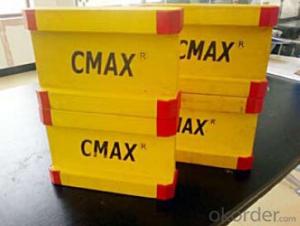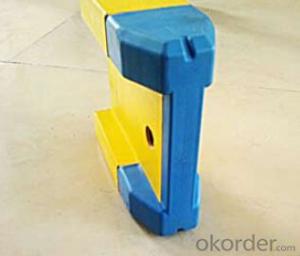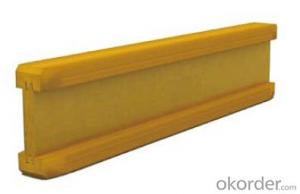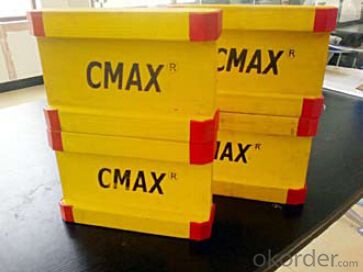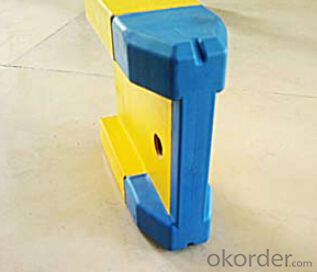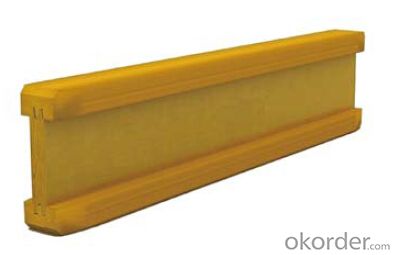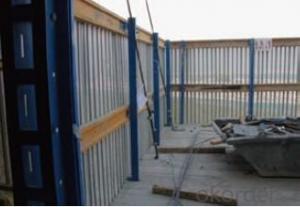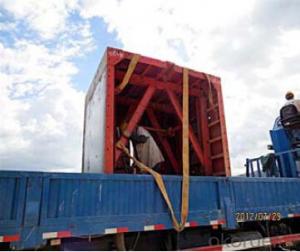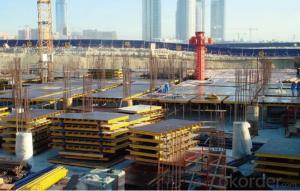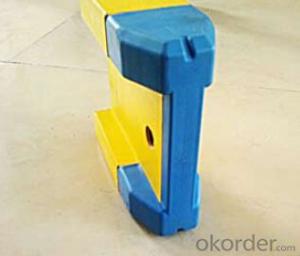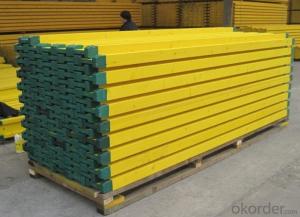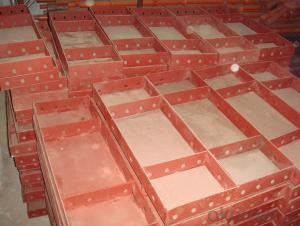Timber Beam Formwork for building Construction
- Loading Port:
- Tianjin
- Payment Terms:
- TT OR LC
- Min Order Qty:
- 50 m²
- Supply Capability:
- 1000 m²/month
OKorder Service Pledge
Quality Product, Order Online Tracking, Timely Delivery
OKorder Financial Service
Credit Rating, Credit Services, Credit Purchasing
You Might Also Like
Plywood --- make perfect concrete surface
WISA-Form Birch is a coated special plywood using in the formwork systems where high
requirements are set on the concrete surface and the times of reuses.
With CNBM timber beam & WISA plywood, the formwork is low weight but high load capacity, it is
widely used in construction.
Characteristics:
◆ Component with high standardization.
◆ Assembling in site, flexible application.
◆ Light weight, easy transportation and storage.
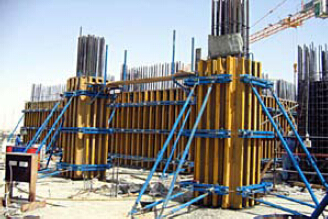
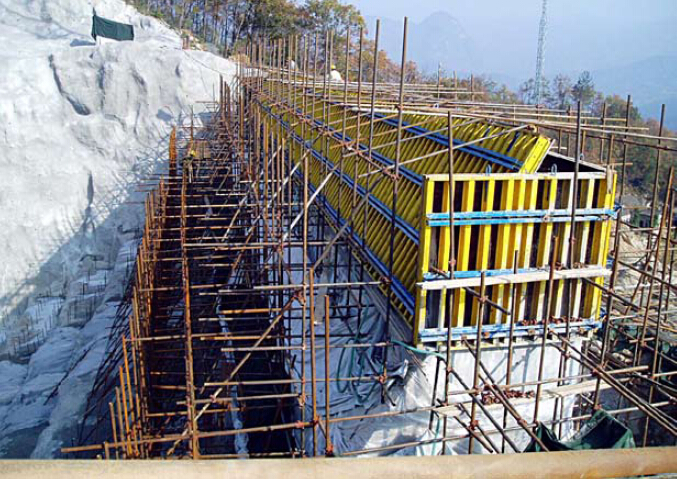
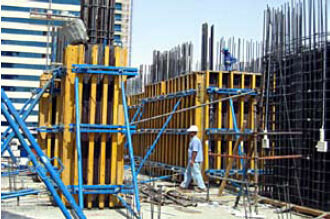
- Q: What are the different sizes and dimensions of steel formwork panels?
- Different construction needs are catered to by steel formwork panels that come in various sizes and dimensions. The manufacturer and specific project requirements determine the sizes and dimensions of steel formwork panels, although common sizes and dimensions are widely available in the market. Typically, the standard dimensions of steel formwork panels range from 1.2 meters to 2.4 meters in length and 0.6 meters to 1.2 meters in width. These standard sizes are designed for easy handling and transportation on construction sites. Additionally, the thickness of steel formwork panels can vary from 3 millimeters to 6 millimeters, depending on the required load-bearing capacity. Custom sizes can also be manufactured to meet specific project needs, which may be larger or smaller than the standard dimensions depending on the complexity and scale of the construction project. Due to the durability and strength of the material, steel formwork panels are relatively heavy. The weight of a steel formwork panel can range from 30 kilograms to 50 kilograms, depending on its size and thickness. In conclusion, the sizes and dimensions of steel formwork panels can vary to meet different construction requirements. It is important to consult with a supplier or manufacturer to determine the most suitable size and dimension for a specific project.
- Q: Can steel formwork be used for structures with high seismic resistance requirements?
- Indeed, structures with high seismic resistance requirements can utilize steel formwork. Renowned for its strength, durability, and stability, steel formwork is well-suited to endure seismic forces. Its rigid framework enables it to withstand lateral forces and vibrations caused by earthquakes. Steel formwork presents numerous benefits for structures with high seismic resistance requirements. Firstly, it provides a robust and dependable support system throughout the construction process, ensuring accurate placement and alignment of reinforcement and concrete. This guarantees proper connection and reinforcement of structural elements, thereby enhancing overall seismic performance. Moreover, steel formwork offers easy customization and adjustment to meet specific design requirements. This malleability facilitates the construction of intricate shapes and geometries, further fortifying the structure's integrity and resistance to seismic forces. Additionally, steel formwork enables efficient construction as it can be effortlessly assembled, disassembled, and reused, thereby saving time and resources. Furthermore, steel formwork boasts a high load-bearing capacity, which is essential for structures with high seismic resistance demands. It can bear heavy loads and distribute them evenly, minimizing the risk of structural failure during seismic events. Moreover, steel formwork exhibits exceptional durability and can withstand repeated use, ensuring its long-term performance in seismic-prone regions. In conclusion, steel formwork effectively caters to structures with high seismic resistance requirements. Its strength, durability, flexibility, and load-bearing capacity make it an ideal choice for withstanding seismic forces, guaranteeing the structural integrity and safety of the building.
- Q: How does steel formwork handle different concrete admixtures?
- Steel formwork, with its versatility and durability, is capable of managing different concrete admixtures. These admixtures, which improve the properties of concrete, include strength, workability, durability, and setting time. An advantage of steel formwork is its resistance to chemical reactions caused by concrete admixtures. Steel is highly resistant to corrosion and can withstand the alkaline environment of concrete and potential chemical reactions caused by admixtures. Steel formwork effectively handles various admixtures like accelerators, retarders, plasticizers, and air-entraining agents. Accelerators speed up the concrete setting and hardening process, while retarders slow down the setting time. Steel formwork accommodates the different setting times caused by these admixtures, allowing for efficient construction. Plasticizers, also known as water-reducers, are commonly used to improve concrete workability and flow. Steel formwork easily handles the increased fluidity of concrete with plasticizers, ensuring it maintains its shape and does not leak or slump excessively. Air-entraining agents introduce microscopic air bubbles into concrete, enhancing its durability and freeze-thaw resistance. Steel formwork handles the entrapped air, maintaining the required consistency and structural integrity of the concrete. Moreover, steel formwork can also manage specialized admixtures like corrosion inhibitors, shrinkage reducers, and waterproofing agents. These admixtures address specific challenges in concrete construction, and steel formwork provides a reliable and stable platform for their successful implementation. In conclusion, steel formwork is a strong and adaptable system that effectively handles various concrete admixtures. Its corrosion resistance and stability make it an ideal choice for accommodating the chemical reactions and properties of different admixtures, resulting in high-quality and durable concrete structures.
- Q: How does steel formwork affect construction speed and efficiency?
- There are several ways in which the use of steel formwork can greatly improve the speed and efficiency of construction. To begin with, steel formwork is extremely durable and can withstand repeated use, which reduces the need for replacing or repairing materials. This saves both time and money by preventing delays caused by damage or deterioration of the formwork. Furthermore, steel formwork ensures a high level of accuracy and precision during construction. Its strong structure guarantees consistent dimensions and alignment, resulting in uniform concrete placement and minimizing the need for adjustments. This saves time and effort, allowing construction teams to work more efficiently and complete projects on schedule. Moreover, steel formwork is highly versatile and adaptable. It can easily be customized to fit various shapes and sizes, making it ideal for constructing complex structures. This eliminates the need for extensive manual cutting or modification of materials, saving both time and labor. Additionally, steel formwork offers a quick and easy assembly and dismantling process. Its modular design allows for simple installation and removal, reducing the time required for preparation and cleanup. This not only speeds up construction progress but also minimizes downtime between different stages of the project. Lastly, steel formwork has an excellent load-bearing capacity. Its sturdy construction can support heavy concrete loads, allowing for larger pours and reducing the number of breaks needed. This increases the productivity of the construction team, as they can complete larger sections of the structure in a shorter amount of time. In conclusion, the use of steel formwork significantly improves construction speed and efficiency by providing durability, accuracy, versatility, quick assembly, and load-bearing capabilities. Its ability to reduce construction time, minimize errors, and optimize resource utilization makes it a preferred choice for many construction projects.
- Q: How is steel formwork used in construction projects?
- The technique of steel formwork is widely employed in construction, using steel panels and frames to create temporary molds or formworks. These formworks are utilized to shape and provide support for wet concrete until it sets and solidifies into the desired structure. When it comes to construction projects, steel formwork is mainly utilized for large-scale endeavors like high-rise buildings, bridges, and dams. The use of steel formwork offers several advantages over traditional timber formwork, including enhanced strength, durability, and the ability to be reused. To utilize steel formwork, the initial step involves designing and fabricating the steel panels and frames based on the specific project requirements. These panels are typically made from high-quality steel, ensuring they are strong enough to withstand the weight and pressure of wet concrete. Once the steel formwork is fabricated, it is transported to the construction site and assembled by skilled workers. The panels are connected together using various methods such as clamps or bolts, creating a sturdy framework. This framework serves as a mold, providing support and containment for the wet concrete. The steel formwork is then meticulously positioned and aligned according to the project plans. Reinforcement bars, also known as rebars, are often placed within the formwork to add strength to the final structure. Once everything is in place, the concrete is poured into the formwork, filling the designated areas. During the curing process, the steel formwork plays a vital role in ensuring the concrete maintains its shape and strength. The steel panels prevent the concrete from bulging or deforming under its own weight, resulting in a finished product that is of high quality and structurally sound. After the concrete has hardened and gained enough strength, the steel formwork can be removed. Due to its durability and ability to be reused, the steel formwork can be disassembled and utilized in multiple construction projects, making it a practical and sustainable option. In conclusion, steel formwork is a crucial element in construction projects, offering a reliable and efficient method for shaping and supporting wet concrete. Its strength, durability, and reusability make it a popular choice for large-scale projects, ensuring the successful completion of various structures.
- Q: Can steel formwork be used for both symmetrical and asymmetrical concrete elements?
- Yes, steel formwork can be used for both symmetrical and asymmetrical concrete elements. Steel formwork is versatile and can be easily adjusted or modified to accommodate different shapes and sizes of concrete elements, regardless of their symmetry.
- Q: Can steel formwork be used for both interior and exterior applications?
- Yes, steel formwork can be used for both interior and exterior applications. Steel formwork is durable, strong, and resistant to weather conditions, making it suitable for various construction projects. It is commonly used for both interior and exterior applications such as building walls, columns, slabs, beams, and other structural elements. Steel formwork provides a stable and rigid framework for concrete pouring, ensuring the accuracy and quality of the final construction. Additionally, steel formwork can be reused multiple times, making it a cost-effective choice for both interior and exterior applications.
- Q: Are there any specific considerations for using steel formwork in seismic zones?
- Yes, there are several specific considerations for using steel formwork in seismic zones. Firstly, steel formwork provides better strength and stiffness compared to other formwork materials such as wood or aluminum. This is crucial in seismic zones where the structure needs to withstand the lateral forces generated by an earthquake. The high strength of steel formwork helps in preventing deformation or failure during seismic events. Secondly, steel formwork offers better durability and reusability. In seismic zones, there is a higher likelihood of frequent earthquakes, and the formwork needs to withstand multiple cycles of loading and unloading. Steel formwork is known for its robustness and ability to withstand repeated use, making it suitable for seismic zones where regular formwork replacement may not be feasible. Another consideration is the design of the steel formwork panels. In seismic zones, it is important to ensure that the formwork panels have sufficient stiffness to resist lateral forces. This can be achieved by using thicker steel plates or adding stiffening elements to the formwork structure. Additionally, the joints between formwork panels should be well-designed and properly reinforced to resist the dynamic forces induced by earthquakes. Moreover, the connection between the steel formwork and the supporting structure should be carefully designed. In seismic zones, it is crucial to ensure a strong and rigid connection to prevent the formwork from detaching or collapsing during an earthquake. Adequate reinforcement, proper anchorage, and well-designed joint details are essential to ensure the stability of the formwork system under seismic loads. Lastly, it is important to consider the construction sequence and the timing of formwork removal in seismic zones. The formwork should be designed to provide sufficient lateral support to the concrete during the curing process, as premature removal of formwork can compromise the structural integrity. The formwork removal should be planned carefully to avoid any sudden changes in the load distribution that could potentially affect the seismic performance of the structure. In summary, when using steel formwork in seismic zones, considerations such as strength, durability, design, connection, and construction sequence are important to ensure the safety and stability of the formwork system and the overall structure during seismic events.
- Q: What are the common safety precautions when working with steel formwork in extreme temperatures?
- When working with steel formwork in extreme temperatures, it is important to take certain safety precautions to ensure the well-being of the workers and the successful completion of the project. Some common safety precautions to consider are: 1. Adequate Personal Protective Equipment (PPE): Workers should wear appropriate PPE, such as heat-resistant clothing, gloves, and safety glasses, to protect themselves from extreme temperatures and potential hazards. 2. Regular hydration: In extreme temperatures, it is crucial for workers to stay hydrated. Encourage frequent water breaks and provide access to cool drinking water on-site. 3. Providing shade and rest areas: Create shaded areas or rest spaces where workers can take breaks and escape the direct heat. This can help prevent heat-related illnesses like heat exhaustion or heat stroke. 4. Training and awareness: Ensure that all workers are properly trained and educated about the potential risks associated with working in extreme temperatures. They should be aware of the signs of heat-related illnesses and know how to respond in case of an emergency. 5. Monitoring weather conditions: Regularly check weather forecasts and be aware of extreme temperature warnings or heat advisories. Adjust work schedules accordingly, if possible, to minimize exposure to extreme heat. 6. Implementing a buddy system: Establish a buddy system where workers can look out for each other. This helps ensure that if someone is experiencing any heat-related issues, they can be identified and assisted promptly. 7. Regular breaks and scheduling: Plan work schedules in a way that allows for frequent breaks and rest periods. This helps prevent overexertion and reduces the risk of heat-related illnesses. 8. Proper ventilation: Ensure that the work area is properly ventilated to allow for air circulation and minimize the build-up of heat. This can be achieved by using fans or natural ventilation methods. 9. Regular communication: Maintain open channels of communication with workers to keep track of their well-being and address any concerns they may have regarding working in extreme temperatures. 10. Emergency response: Have a well-defined emergency response plan in place. This should include procedures for addressing heat-related emergencies, such as providing first aid, accessing medical assistance, and evacuating the work area if necessary. By following these common safety precautions, workers can minimize the risks associated with working in extreme temperatures when using steel formwork and ensure a safe and productive work environment.
- Q: What are the factors to consider when selecting steel formwork?
- When selecting steel formwork, there are several factors to consider. 1. Strength and durability: Steel formwork should be strong enough to withstand the weight of the concrete and the forces applied during the pouring and curing process. It should also be able to withstand multiple uses without losing its structural integrity. 2. Flexibility and adaptability: The formwork should be able to be easily adjusted and modified to accommodate different shapes and sizes of concrete elements. This is particularly important in construction projects that involve complex or irregular structures. 3. Ease of assembly and dismantling: The formwork system should be quick and easy to assemble and dismantle, as this can significantly impact the overall construction timeline. The use of standardized components and a simple connection system can contribute to faster assembly and dismantling. 4. Surface finish: The quality of the surface finish of the concrete is important, especially for architectural projects. Steel formwork should provide a smooth and even surface, without any visible marks or imperfections, to ensure a high-quality end result. 5. Cost-effectiveness: The overall cost of the formwork system, including the initial investment, maintenance, and reusability, should be considered. While steel formwork may have a higher upfront cost compared to other materials, its durability and reusability can make it a cost-effective choice in the long run. 6. Safety: The safety of workers during the construction process is paramount. Steel formwork should be designed and manufactured with safety features such as non-slip surfaces, secure connections, and adequate bracing to prevent accidents or collapses. 7. Environmental impact: The environmental impact of the formwork material should also be taken into account. Steel formwork is often considered more environmentally friendly compared to traditional timber formwork due to its reusability and recyclability. By considering these factors, construction professionals can make an informed decision when selecting steel formwork that meets their project requirements and delivers optimal results.
Send your message to us
Timber Beam Formwork for building Construction
- Loading Port:
- Tianjin
- Payment Terms:
- TT OR LC
- Min Order Qty:
- 50 m²
- Supply Capability:
- 1000 m²/month
OKorder Service Pledge
Quality Product, Order Online Tracking, Timely Delivery
OKorder Financial Service
Credit Rating, Credit Services, Credit Purchasing
Similar products
Hot products
Hot Searches
